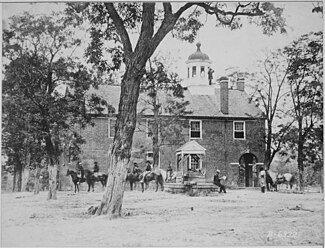38°51′9″N 77°18′15″W / 38.85250°N 77.30417°W
| Battle of Fairfax Court House | |||||||
|---|---|---|---|---|---|---|---|
| Part of American Civil War | |||||||
 Mathew Brady's photograph of Union Army soldiers guarding Fairfax Court House during the American Civil War | |||||||
| |||||||
| Belligerents | |||||||
|
|
| ||||||
| Commanders and leaders | |||||||
| Major Seth Pierre Remington |
Major General J.E.B. Stuart Brigadier General Wade Hampton III Major John H. Whitaker † | ||||||
| Strength | |||||||
| 87[1] | 2,000[2][3][4] | ||||||
| Casualties and losses | |||||||
| 4 killed, 14 wounded and captured, 19 captured and 4 seriously wounded and left at a nearby home[5] | 5 killed, unknown wounded, 14 initial prisoners rescued[1] | ||||||
The Battle of Fairfax Court House was fought during the Gettysburg Campaign of the American Civil War between two cavalry detachments from the Union Army of the Potomac, commanded by General Joseph Hooker, and the Confederate Army of Northern Virginia, commanded by General Robert E. Lee.
The Confederate cavalry leader General J.E.B. Stuart was keen to restore his prestige after two humiliating encounters with Union cavalry, and as the main body crossed the Potomac into Maryland, he received permission to detach three brigades and ride around the entire Union army to gather supplies and intelligence, and damage lines of communication.
At Fairfax Court House, Virginia, on June 27, one of Stuart’s brigades, led by Brigadier General Wade Hampton, was surprised by a small detachment of the 11th New York Cavalry under Major Remington, which initially drove them into the woods, but were so heavily outnumbered that they had to retreat. Although technically a Confederate win, this small engagement had a major impact on the outcome of Gettysburg, since it delayed Stuart’s arrival, depriving Lee of essential knowledge of the enemy’s whereabouts.
- ^ a b Cite error: The named reference
Hartwell85was invoked but never defined (see the help page). - ^ Dagwell, George A. Chapter VIII: The Fairfax Fight in Smith, Thomas West. The Story of a Cavalry Regiment: "Scott's 900" Eleventh New York Cavalry: From the St. Lawrence River to the Gulf of Mexico, 1861–1865. Chicago: The Veterans Association of the Regiment, 1897. OCLC 550919. Retrieved June 26, 2013. p. 80. Retrieved June 26, 2013.
- ^ Wittenberg, Eric J., and J. David Petruzzi. Plenty of Blame to Go Around: Jeb Stuart's Controversial Ride to Gettysburg. New York: Savas Beatie, 2006. ISBN 978-1-932714-20-3. pp. 299–300.
- ^ Wittenberg, 2006, p. 300 shows that three days after the battle, Hampton's brigade had a roster of Hampton and 4 staff, 6 colonels and 165 officers and 1,823 in the 6 regiments or legions, for a total of 1,999 men.
- ^ O'Neill, Robert F. Chasing Jeb Stuart and John Mosby: The Union Cavalry in Northern Virginia from Second Manassas to Gettysburg. Jefferson, NC: McFarland & Co., 2012. ISBN 978-07864-7085-3. p. 246.